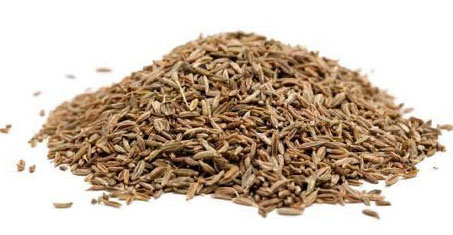What Is Cumin Seed?
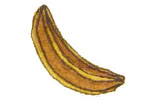
Cumin Seed (Cuminum cyminum) is an annual herb that grows to be about a foot tall. Its seeds are yellow-brown in color and they are harvested by hand. White or pink flowers blossom on the cumin plant during its three to four month growing period during the hot summers.
Cumin Seed Plant and Cultivation
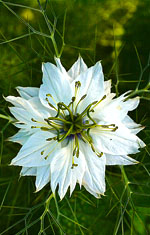
In Syria, cumin is also sown as a winter crop, e.g. from mid-November to mid December, with a possible extension up to mid-January; the crop is ready for harvesting in June-July. Cumin requires a moderately cool and dry climate for its growth, with a temperature between 25° and 30° C. The crop is highly sensitive to rain, and any rain during harvesting time reduces yield and crop quality. The crop is most vulnerable to frost damage, especially at flowering and early seed formation stages. Control measures include: spraying with sulfuric acid (0.1%), irrigating the crop prior to frost incidence, setting up wind breaks against cool waves, or creating an early morning smoke cover. Cumin grows best on well drained sandy loam to loamy soils with a pH range of 6.8 to 8.3. Acidic soils and alkaline soil reduce yield unless soil acidity is lowered to pH = 7.5.
Cumin Seed Description
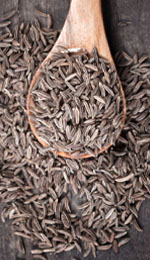
Cumin is the dried seed of the herb Cuminum cyminum, a member of the parsley family. The cumin plant grows to 30–50 cm (12–20 in) tall and is harvested by hand. It is an annual herbaceous plant, with a slender, glabrous, branched stem that is 20–30 cm (8–12 in) tall and has a diameter of 3–5 cm (1 1⁄4–2 in). Each branch has two to three sub-branches. All the branches attain the same height, therefore the plant has a uniform canopy. The stem is coloured grey or dark green. The leaves are 5–10 cm (2–4 in) long, pinnate or bipinnate, with thread-like leaflets. The flowers are small, white or pink, and borne in umbels. Each umbel has five to seven umbellts. The fruit is a lateral fusiform or ovoid achene 4–5 mm (1⁄6–1⁄5 in) long, containing two mericarps with a single seed. Cumin seeds have eight ridges with oil canals. They resemble caraway seeds, being oblong in shape, longitudinally ridged, and yellow-brown in colour, like other members of the Umbelliferae family such as caraway, parsley, and dill.
Uses of Cumin Seed
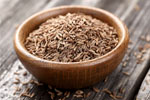
Cumin Seed is high in iron and manganese, supplying seven and three percent respectively of the recommended daily value. It also supplies our bodies with calcium, many vitamins and fiber. Cumin Seed is said to prevent gas, reduce muscle spasms, clear jaundice and stop diarrhea amongst other things. It may also strengthen bones, lower blood sugar and reduce seizures.
10 Health Benefits of Cumin Seed
1 - Relieves Colds, Fevers and Sore Throats - Cumin Seed is high in vitamin C and its anti-fungal properties make it difficult to suffer long from a cold and sore throat if you consume it regularly.
2 - Aids Digestion and Relieves Constipation - Cumin Seed aids in proper digestion of food and the body's ability to absorb nutrients because the enzymes found in cumin help break down the food. Cumin's anti-fungal properties will help to clean out the digestive tract.
3 - May Prevent Cancer - Cumin Seed contains anti-carcinogenic properties which is key for preventing cancer. Cumin Seed also helps to detoxify the liver and prevent free radicals from entering the blood stream. Cumin is a great way to help detoxify your body and keep your insides clean and healthy.
4 - Maintain Healthy Skin - The vitamins found in cumin Seed, both vitamin C and E, are essential for healthy, young looking skin. Cumin's Seed essential oils also keep fungal and microbial infections away.
5 - Regulates blood pressure and heart rate - Being high in potassium - a mineral that helps maintain the electrolyte balance in the body - this seed is an elixir for heart patients. This mineral not only helps in the regulation cell production but also helps maintain your blood pressure and heart rate. Because of its regulatory properties, cumin seed helps patients who have heart disease and helps prevent it as well.
6 - Relieves asthma and cold - The potent anti-inflammatory, anti-bacterial and anti-fungal properties of cumin seed, makes it a great home remedy for cold and asthma. These compounds soothe inflamed muscles and boost your immunity to fight the infection.
7 - Helps prevent anaemia - Iron is the main component in the production of haemoglobin - a substance that carries and transports oxygen throughout our body. 100 grams of cumin seeds contains 11.7 milligrams of iron that makes it the most natural and effective supplement for people suffering from anaemia.
8 - Enhances memory - Packed with minerals like riboflavin, zeaxanthin, vitamin B6, niacin and many more, cumin seed is well known for its ability to maintain and restore memory and mental health.
9 - Helps to deal with insomnia - Cumin Seed contains a high amount of melatonin, which when consumed with bananas increases the production of chemicals within the brain. This concoction helps beat insomnia and gives you a good night’s sleep.
10 - Immunity - An abundance of iron, the presence of essential oils, vitamin-C, and vitamin-A in cumin seed boosts our immune system in a number of ways.
Producing Countries of Cumin Seed
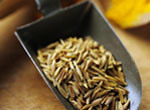
The main producer and consumer of cumin is India. It produces 70% of the world supply and consumes 90% of that (which means that India consumes 63% of the world's cumin). Other producers are Syria (7%), Iran (6%), and Turkey (6%). The remaining 11% comes from other countries. In total, around 300,000 tons of cumin per year is produced worldwide.
Consuming Countries of Cumin Seed

Cumin Seed is extensively used in culinary practices of the Indian Subcontinent and some other Asian, African and Latin American countries as a condiment or spice. Most of the cumin seeds are exported to the countries that do not produce cumin seed themselves and make huge markets for this spice. The major Cumin Seed consuming countries are India, USA, Mexico, Portugal, Spain, Turkey, China, Japan, Netherlands, Singapore, France and Morocco.
Recipe for Beverages with Cumin Seed
Cumin Tea

Ingredients: A: 1 teaspoon cumin seeds B: 250 ml drinking water
Preparation MethodA: Take a vessel and add 1 teaspoon cumin seeds to it. B: Heat it a little on low flame for about 5 seconds. C: Pour 250 ml drinking water into it and let it boil. D: After boiling, let it be covered and untouched for about 5 minutes. E: Strain it into your teacup and enjoy it warm. F: According to your taste you can add honey or a pinch of salt into it.
Recipe for Cooking with Cumin Seed
Cumin Roast Carrots
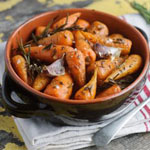
Ingredients: A: 150g/5½oz Chantenay carrots, or other small carrots B: drizzle olive oil C: 2 garlic cloves, unpeeled D: 1 sprig rosemary E: 1 tsp cumin seeds F: salt and freshly ground black pepper G: 2 tbsp chopped fresh chives, to garnish
Preparation MethodA: Preheat the oven to 200C/400F/Gas 6. B: Place the carrots onto a baking sheet, add the garlic cloves, rosemary and cumin seeds and season generously with salt and freshly ground black pepper. Mix together. C: Place in the oven and roast for 10-15 minutes, or until the carrots are tender and golden-brown. D: To serve, transfer the carrots to a serving bowl and garnish with the chopped chives.
Recipe for Dessert with Cumin Seed
Chocolate and cumin fudge

Ingredients: A: 150g of 55% dark chocolate, chopped B: 550g of double cream C: 500g of caster sugar D: 75g of liquid glucose E: 1 tsp cumin seeds
Preparation MethodA: Combine the double cream, caster sugar and glucose in a pan. Place over a low-medium heat and allow to slowly come to the boil, whisking continuously. B: Bring to 118°C and remove from the heat, add the chocolate and cumin and whisk well by hand for 2 minutes. C: Cling film the bottom and sides of a 1inch deep tray. Pour in the fudge mixture and leave to set for at least 1 hour. D: Once set, slice into small cubes and serve.

